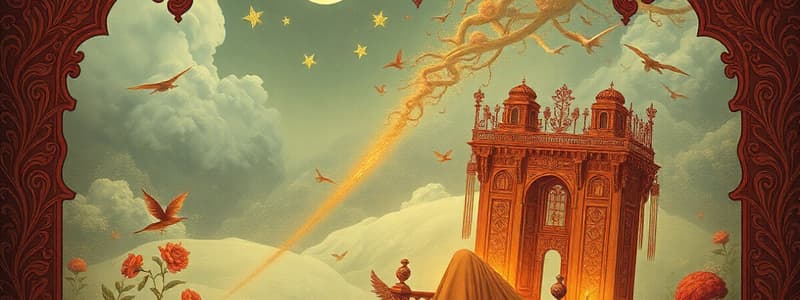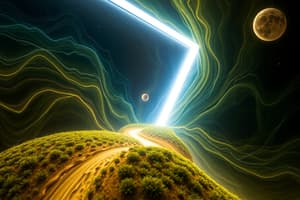Podcast
Questions and Answers
Which of the following best describes the focus of humanities as a branch of learning?
Which of the following best describes the focus of humanities as a branch of learning?
- The study of interactions among people in society.
- The application of scientific methods to understand the natural world.
- Objective, experimentally verifiable data.
- Human opinions, relationships, and expressions of feelings. (correct)
Which activity is most closely associated with expressing values rather than just providing aesthetic pleasure?
Which activity is most closely associated with expressing values rather than just providing aesthetic pleasure?
- Producing a documentary film that highlights social injustice. (correct)
- Creating a sculpture for a museum.
- Painting a landscape that captures the beauty of nature.
- Designing a building with innovative architectural features.
Which of the following distinguishes natural sciences from social sciences?
Which of the following distinguishes natural sciences from social sciences?
- Social sciences rely on controlled experiments, while natural sciences depend on interaction with people.
- Both rely solely on experimental data for conclusions.
- Gathering data for social sciences happens in a laboratory, while natural sciences gather data through interactions.
- Natural sciences use closed systems and controlled experiments; social sciences use open systems and interaction. (correct)
How do the arts uniquely contribute to education, beyond simply providing entertainment or instruction?
How do the arts uniquely contribute to education, beyond simply providing entertainment or instruction?
William Morris is known for leading which of the following movements?
William Morris is known for leading which of the following movements?
If an artist's primary motivation is to critique government policies and inspire social change, which of the following best describes their motivation?
If an artist's primary motivation is to critique government policies and inspire social change, which of the following best describes their motivation?
Which of the following is a characteristic activity related to Prehistoric Art?
Which of the following is a characteristic activity related to Prehistoric Art?
You see a 'Gong and drum ensemble' being performed. Which artistic tradition does this performance belong to?
You see a 'Gong and drum ensemble' being performed. Which artistic tradition does this performance belong to?
Which of the following types of Philippine art serves as concrete evidence of traditional skills and talents, playing a vital role in preserving the culture of the country?
Which of the following types of Philippine art serves as concrete evidence of traditional skills and talents, playing a vital role in preserving the culture of the country?
What is the primary role of 'art appreciation'?
What is the primary role of 'art appreciation'?
Flashcards
Art Appreciation
Art Appreciation
Motivates ideas and allows individuals to illustrate their feelings when viewing art.
Humanities
Humanities
Focuses on human opinions and relationships; more concerned with expressing feelings.
Social Sciences
Social Sciences
A 'soft' science involving interaction with people, open systems, and experimental data.
Natural Sciences
Natural Sciences
Signup and view all the flashcards
Functions of Art
Functions of Art
Signup and view all the flashcards
Purpose of Art
Purpose of Art
Signup and view all the flashcards
Visual Arts
Visual Arts
Signup and view all the flashcards
Performing Arts
Performing Arts
Signup and view all the flashcards
Value of Arts in Education
Value of Arts in Education
Signup and view all the flashcards
Cross-Stitch
Cross-Stitch
Signup and view all the flashcards
Study Notes
- Art appreciation motivates ideas and allows individuals to illustrate their feelings when viewing artwork.
Humanities
- Humanus translates to "educated".
- Humanities focuses on human opinions and relationships.
- Humanities is centered around how a person expresses feelings.
Social Sciences
- Considered a "soft science".
- Involves interaction with people using experimental data.
- Follows an open system
- Data is gathered through interaction.
Natural Sciences
- Considered a "real" or "hard" science".
- Uses controlled experiments with experimental data
- Follows a closed system
- Data is gathered in a laboratory.
Key Concepts in Art
- Creativity is an essential element.
- Art is a universal concept.
- Art has a meaning.
Functions of Art
- Art serves individual, social, economic, political, historical, cultural, physical, and aesthetic functions.
Purpose of Art
- Art aims to create beauty, provide decoration, reveal truth, express values, commemorate experience, and create harmony.
Classification of Art
- Visual art includes sculpture, architecture, drawing, and photography.
- Performing arts includes theatre, music, dance, film, installation art, opera, and stagecraft.
- Literary arts are another category.
Value of Arts in Education
- Connects imaginations with the profound questions of human existence.
- Helps to present issues and ideas to teach, persuade, and entertain.
- Shapes spiritual, political, economic, cultural, and social environments.
- Offers sources of enjoyment and investigates relationships between thought and actions.
- Teaches self-discipline, reinforces self-esteem, and fosters thinking skills and creativity.
- Values teamwork and cooperation.
William Morris
- Born in 1834
- Led the Arts and Crafts movement in 19th century Europe.
Types of Arts and Crafts
- Cross-stitch is popular counted-thread embroidery with X-shaped stitches in tiled patterns.
- Crochet is the process of creating fabric from yarn using a hook.
- Sewing is the craft of fastening objects using stitches made with needles and thread.
- Weaving is a fabric production method in which yarns are interlaced.
- Tatting is a technique for handcrafting durable lace made of knots and loops.
- Shoemaking is the process of making footwear.
- Lace is openwork fabric.
- Macrame is textile-making that requires few tools.
- Millinery is the manufacture of hats.
- String art is the arrangement of colored thread.
Principles of Art
- Harmony
- Variety
- Balance
- Movement
- Emphasis
- Proportion
- Rhythm
Art Elements
- Content
- Subject
- Meaning.
Primary Motivations of Art
- Acting
- Healing
- Political Change
- Propaganda
- Communication
Prehistoric Art
- Includes the Stone Age, Neolithic Age, Bronze Age, and Iron Age.
Stone Tools
- Sedimentary
- Metamorphic
- Volcanic
- Neoliths were the first stone tools.
- Pebble tools, bifacial tools, flake tools, and blade tools also existed.
Pre-colonial Art
- Includes various forms like Agung, Banog-banog, Blit B'laan, Canao, Gangsa, Inamong, Kadal Iwas, Kashawing, Kinabua, Mamakar, Man-manok, Mayvanuvanua, Mumbaki, Ngilin, Pagdiwata.
- Pangalay is also known as Sea Gypsies.
- Sampak, Saut and Talip are also included.
Medieval Arts
- Included illuminated manuscripts with colorful religious texts.
- Metalwork for creating religious objects.
- Silversmithing and Goldsmithing for jewelry.
- Paintings used Fresco and Panel.
- Bayeux tapestry used embroidery in colored wool.
- Ceramics, Stained Glass and Heraldry were also art forms.
Philippine Artistic Handicrafts
- Play a vital role in preserving culture and traditions.
- Serve as evidence of traditional art, skills, talents, and the Filipino way of life.
GAMABA
- Philippine GAMABA Awards (Gawad sa Manlilikha ng Bayan Awards)
- Apo Whang-od
Kulintang
- Gong and drum ensembles indigenous to the Sulu and Mindanao islands in the southern Philippines and northern Borneo.
Buri
- A plant native to the Philippines used for weaving various products like mats, bags, and hats.
Phases of Art
- Creation of Forms, Ideas, and Materials.
Studying That Suits You
Use AI to generate personalized quizzes and flashcards to suit your learning preferences.




